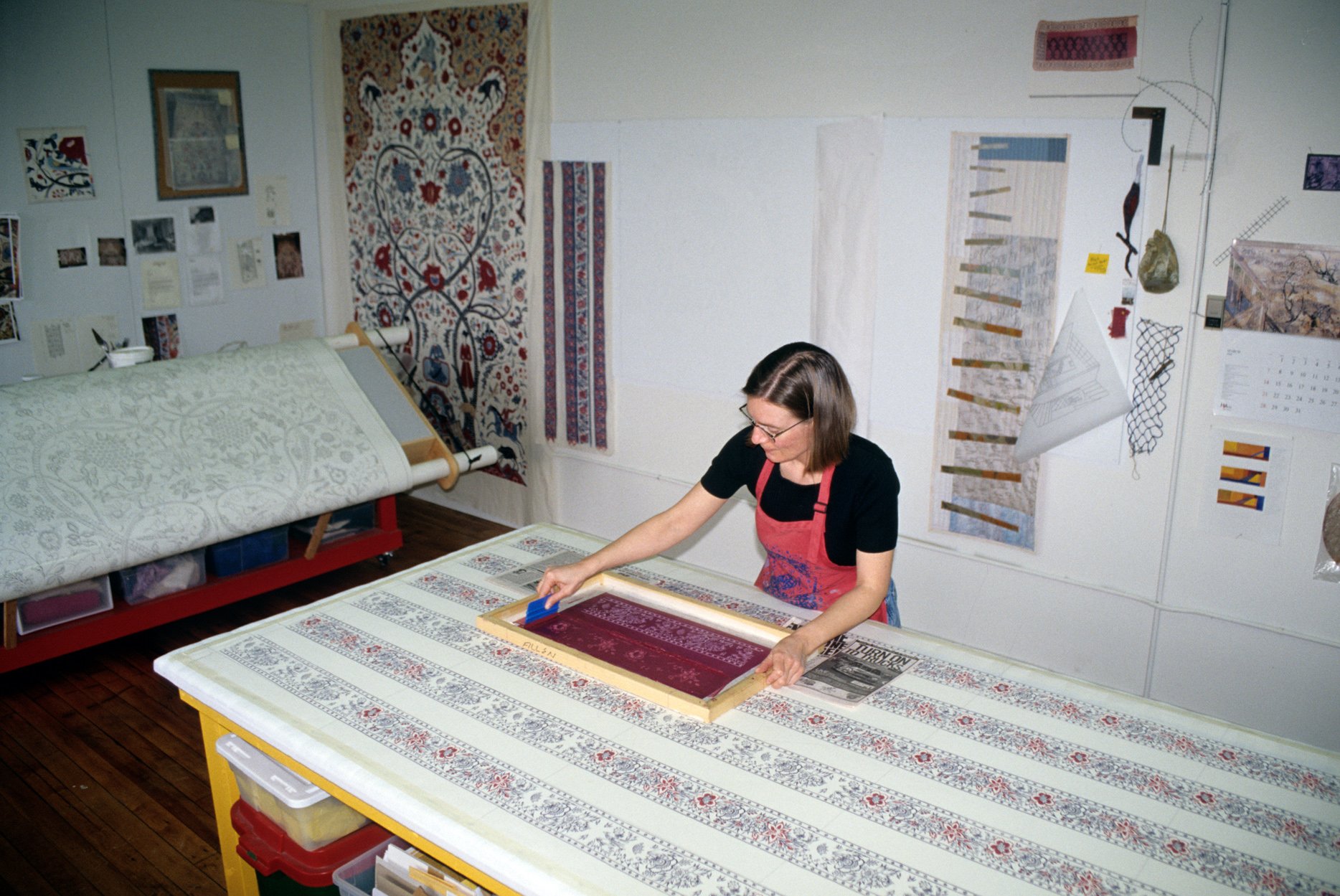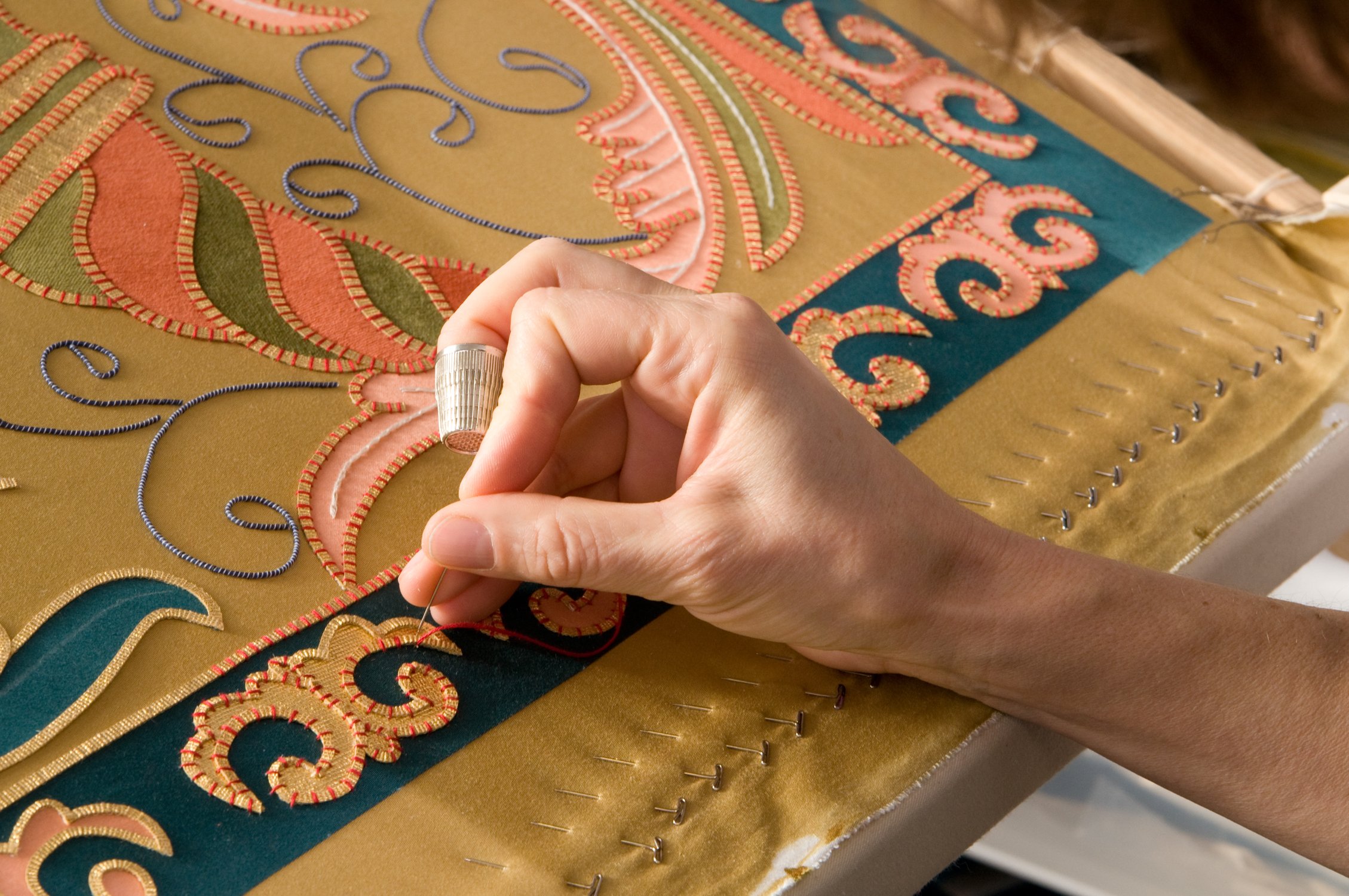Textile Replication
Contact: heatherhietala@gmail.com
Morland Room Drapery Project 1997 - 1998, Biltmore Estate, Asheville, NC
Bed canopy and drapes as part of the Morland Room, one of a suite of women’s guest rooms on the third floor of the Biltmore Estate, Asheville, NC, opened in 1999.
Bed Canopy and Drapes Replication Project, Morland Room
In 1997 I was approached by the Biltmore Estate to make a textile replication or exact copy of a set of palampores that were in their collection to recreate the bed canopy and side drapes for the Morland Room. The palampores were 71" x 115." They were from the early 1800's and purchased in India on one of Mr. Vanderbilt's many world travels. My job was to replicate the look and feel of the original textiles which were stenciled, resist dyed, and painted using indigo and natural dyes. To create the bed canopy and side drapes I replicated 3.5 palampores and additional borders.
Using slides of a palempore projected on a large piece of white photo backdrop paper I created a 71" x 115" full scale working drawing. For longevity the project used textile paints to simulate the look of the original natural dyes. I created a palette based on the colors as they were in 1997 when I began the project. Using my background in weaving, a local woodworker and I designed a 2' x 8' light table that was cantilevered off one of my 4' x 8' print tables. Wooden yokes at either end of the light table held in place 4" PVC pipes that in turn were held in traction by bicycle inner tubes. I attached the full scale working drawing to the PVC pipes so I could advance it back and forth over the light table similar to how one loads a SLR camera with film. A 12' long piece of fabric was attached to the top PVC and wound on similar to winding the warp onto a loom. I began painting at the bottom of the image and would advance the cloth and the working drawing after each section was completed. In order to retain the feeling of the handmade original I was to replicate everything, the spills, drips and any irregularities in the design. I created silk-screens to recreate the effect of the wood block printed borders. The entire process took 18 months. Stephens Upholstering in Asheville fabricated the bed canopy and drapes. Named for the English painter George Morland; the Morland Room, one room of a suite of women's guest rooms on the third floor opened to the public in 1999.

Painting textile inks using the working drawing on the light table under the fabric for reference.

A promotional photo for the Ambassador, a Biltmore Publication.

Screen printing the borders. To the left is the cantilevered light table loaded with the working drawing and the first finished panel on the wall.
Pelment Replication Project 2009 - 2011, Biltmore Estate, Asheville, NC
The replicated pelmets in place over the windows in the Second Floor Living Hall Biltmore Estate, Asheville, NC.
Pelmet Replication Project, Second Floor Living Hall
In 2006 I submitted a proposal to Darren Poupore, then Curator of Collections, at the Biltmore Estate to replicate, as close as possible, 4 (101" x 21") pelmets for the Second Floor Living Hall. The project took 26 months and involved creating numerous intricate working drawings; one for reference, one to paint for color reference and one to cut up into patterns. The original was available for color matching, then hand painting velvet and combed cotton sateen fabrics. A silk linen rep weave fabric was gilded with 24 kt gold and cut in tiny strips to emulate gilded ribbons. I learned to spin to recreate specialty threads for couching and spent 16 months hand embroidering using the chain stitch, the stem stitch and various methods of couching. These photos illustrate the story of how this incredible replication project unfolded.
Sept. 13, 2013, UNCTV episode on the restoration of the Second Floor Living Hall. My project is not included but the episode is very informative.

At the Biltmore with the original pelmet creating color samples using acrylic paint. On the table is the gilded fabric that will be cut into ribbons and a full scale working drawing.

Sampling thickened ProcionMX dyes that will be used to paint the fabrics. On the wall is a color coded full scale working drawing.

Using a tacking iron to tack down the individual pieces of dyed fabric. A working drawing is under the fabric and illuminated by a light table.

One panel ready for embroidery, I modified a huge quilting frame to serve as an embroidery hoop.

Using a thimble to couch down the 24kt gilded ribbon edging.

Sewing the borders and hand dyed brown velvet side panels to a finished panel.
Molly Gregory Silverware Tray Replication, Asheville Art Museum 2021
Molly Gregory Silverware Tray Replication, Asheville Art Museum
In 2021 the Asheville Art Museum approached me to replicate two linen textiles when they were restoring silverware trays by Molly Gregory for the exhibition; Modernist Design at Black Mountain College October 22, 2021 - Jan 22, 2022. The textiles were part of a set of unusual silverware trays made by Mary "Molly" Gregory for the Dreier family circa 1941 - 1945. Molly Gregory was the Faculty in Woodworking at Black Mountain College 1941 - summer 1947.
The original textiles were created of a fine hand-woven linen and hand sewn. I used a natural linen and tea and sumi dyed threads to recreate the feeling of the original textiles. The sumi dyed threads were use to embroider, recreating the look of the original hand-woven selvage.



